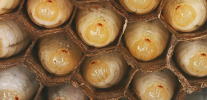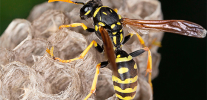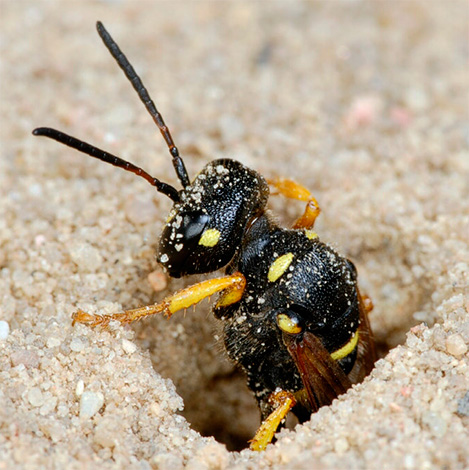
Earthen wasps are an exclusively popular name: entomologists do not know such insects. In the scientific classification there are, for example, road, sand, digging wasps, but earthen - no.
The fact is that in the people "earth wasps" are called absolutely any wasps, which simply make their nests in the ground. Most often, they take the usual paper wasps to the earthen people, who chose not the roof of the barn, but the abandoned underground ant-hill or the rodent hole, to locate their home.
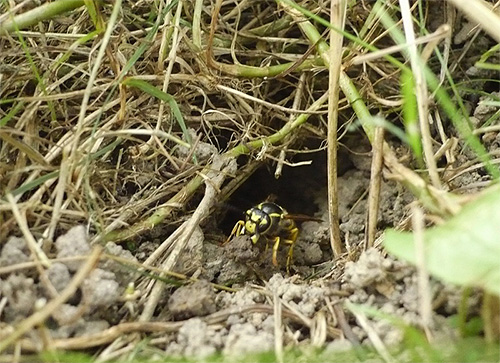
It is interesting
Paper wasps are the most common and familiar to all since childhood slender yellow striped black insects. They flock to the smell of fish or watermelons in the markets or country picnics, and it is from them that they are so diligently trying to get rid of in the summer cottages and apiaries.Paper wasps were called because they build their nest from chewed bark, which, in a mixture with their saliva, forms a parchment-like mass.
Moreover, sometimes trying to get rid of the so-called earthen wasps, the owners of the suburban area actually struggle with the hornets, who also sometimes set up their nest in the ground. Hornet ordinary its coloring is quite similar to the wasp, only much larger.


Few people think about what kind of insect has settled in the garden, because the main thing here is to get rid of unwanted “earthen” inhabitants as quickly as possible, who are fully capable of attacking with a swarm and seriously biting.
Feedback
“We had to fight earthy wasps last year. They made a nest just under a rock on an alpine hill. There was a special drainage so that the water did not stagnate, and they settled in this drainage system. The main problem was that the nest could not be burned or poisoned with kerosene, because many elite plants were growing on the hill. I had to buy Aktar and do everything in a few steps. I came at night on the lawn, sprayed the entrance to the nest with diluted Aktar, and in addition sprinkled Chlorpyrifos near it. Wasps very quickly became less, but they did not stop flying.So he hunted them every three or four days in the evenings, and after three weeks they completely stopped flying out of the hole. I don’t know if they were bred or not, because I don’t want to dig the whole hill just for this. ”
Pavel, Dnepropetrovsk
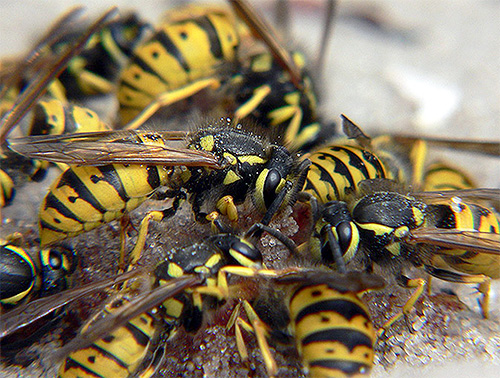
A little bit about the biology of earthworms
The bites of earthen wasps are absolutely no different from the bites of fellows living in a nest under the roof of a barn or on a tree branch. And this is logical, because the location of the home of the wasp does not affect its biology.
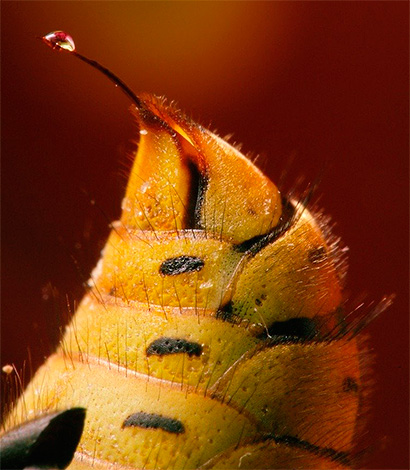
Paper wasps usually settle in the ground for two reasons: either because of a lack of suitable places to attach a suspended nest, or simply because of the presence of an overly attractive hole or shelter underground. The choice of future habitat is entirely carried out by the uterus - it is she who in spring searches for the most suitable conditions for building a nest.
In the photo - an earth wasp at the entrance to the burrow:

At the beginning of the warm season, the wasps set up a nest in the ground, collectively carry food for rearing larvae there, and by the end of summer young females and males appear ready for breeding in the underground dwelling. After mating, the fertilized females leave for the winter, and the next year they begin the cycle anew.
It is worth noting that the wasps did not normally use the same nest located in the earthen hole twice, so if there are insects in the garden this year, it is very likely that next year they will not be here.
However, in addition to the usual paper there is another group of earth wasps, leading a completely different way of life. These are solitary hunters, the females of which catch other insects, paralyze them with their poison, and then hide them in small underground nests, where they lay one egg in their bodies. After that, the female clogs its earthen mink, and after a while the larva is hatching from the egg, slowly eating the still alive, but immobilized prey.
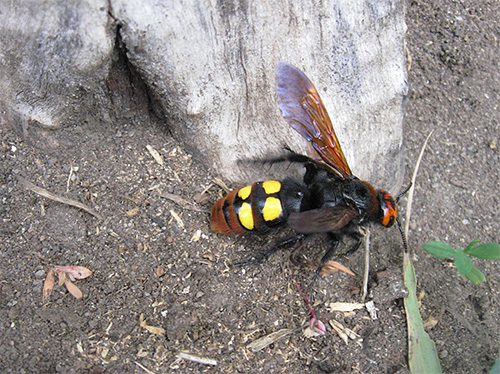
The larva of an earthen wasp begins to feed from those parts of the body that do not lead to the instantaneous death of the insect-victim - from the intestine, excretory and reproductive systems. Only at the end of the predator gets to the nervous system and heart, and then pupates and winters. The following year, an adult wasp is selected from the earthen mink.

It is interesting
Single earthen wasps are known as versatile and very strong predators.Some species of their larvae are exclusively poisonous spiders, and, for example, the whole subfamily of these insects feeds only on bedbugs, including bug insect bug. Meanwhile, ordinary paper wasps also feed their larvae with other insects, and the so-called bee wolf, or philanthropist, hunts only bees, which are extremely unloved by beekeepers.
Among the single earthen wasps there are species that possess a very strong poison - such that ordinary wasps simply do not come in any comparison. For example, some road wasps are included in the Schmidt index (the scale for assessing the pain of insect bites) as one of the most painful stinging insects in the world: only the ant-bullet from South America bites them more strongly. However, fortunately, road wasps are insects rather rare, and even if they suddenly settle in their summer cottage, they are most likely not to cause any problems to the owner.
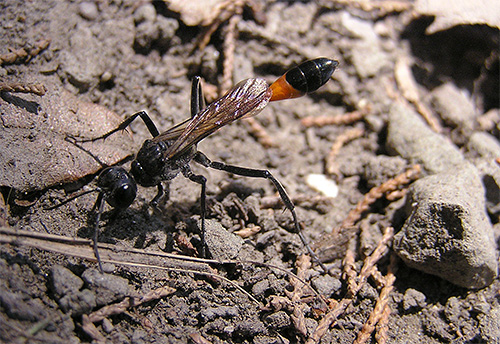
Is it worth it to display them?
Due to the fact that earthen wasps actively catch other insects (including agricultural pests), in some cases getting rid of them means the destruction of very useful helpers in the struggle for the harvest.
In this regard, the question arises: is it worth it at all to destroy the earth wasps at the summer cottage? Indeed, is it necessary to fight earth wasps if one of their nests consumes at least 50-70 harmful insects per day, including caterpillars, bedbugs and aphids?

In fact, to make the right decision you need to take into account some additional important points.
If a wasp nest is located in the center of a flower bed or beds, if insects interfere with the necessary work at the site, constantly fly near the table, summer kitchen or playground for children, you need to display them without a doubt. It is also necessary to destroy the nest of earth wasps if it is located on a potato garden: in August-September, when the potatoes need to be harvested, a disturbed swarm can strongly bite the gardeners.

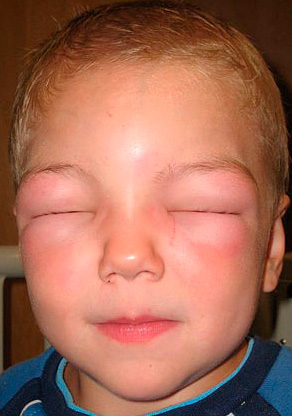
If the wasps settled somewhere in the corner of the garden and do not interfere with anyone, then you should not get rid of them - let the insects help to fight pests. Even if earthen wasps were chosen by some kind of garden, but the vegetables on it will need to be dug out only in late autumn, you can also not touch them - the nest will empty by itself.
Removal of earth wasps from the site: rules and methods
The fight against wasps in the land is carried out by several methods, among which there are three main ones.
- Burning out the nest is probably the most reliable way. For its implementation, 1-2 liters of kerosene or gasoline is poured into the hole, and a “track” with a length of several centimeters is made of them, which is then set on fire. An underground nest burns out very quickly due to the abundance of paper cells in it.

- Filling the nest with boiling water. This is a less efficient method, so often repeated treatment is required for complete destruction. Using this method, it is important to remember that after each such fill, the entrance to the nest should be covered with a stone so that living, but extremely angry, insects do not fly out.

- Destruction of earthen wasps with insecticides. To do this, a solution of a powerful poisonous agent is poured into the hole (for example, Cucaracha, Get, Karbofos, Solfisan, Aktar), and the entrance is plugged with a gag soaked in the same preparation. It should be noted that this method, though effective, is quite expensive.


It is also possible to bring earth wasps using poisoned baits: this is a rather long, but easy to implement method. Syrup or honey is poured on a saucer or in a glass.in which boric acid or any effective insecticidal drug (preferably odorless, for example, Get) dissolves, after which the bait is placed near the nest. All wasps that “eat” the solution die, so with the constant updating of the poison it is possible to destroy all the ground wasps in a week or two.
Feedback:
"Common situation. We had about two years ago. Wasps at the entrance to the garden in the ground made a nest. And it seemed they didn’t interfere with anyone, but once his husband installed light bulbs next to him for lighting and was bitten by earthen wasps. And not one, but a whole swarm attacked him, but he was dressed, and therefore got off easily. After that we decided to withdraw them. We just helped pouring water. Husband in the evening pulled the hose to the gate, turned on the water and inserted the hose into the hole. An hour later, the nest was in the center of a large puddle. Apparently, all the wasps died, because the more we didn’t see them near this nest. ”
Olga, Moscow
Whatever way of getting rid of earthy wasps you choose, it is necessary to observe safety precautions, otherwise the consequences of such a “hunt” can be very deplorable. Let's find out how you can protect yourself during the operation to destroy the wasp nest in the ground.
Safety when removing insects
Fighting earthen wasps requires caution, as it always carries the risk of stinging. In some cases that are especially dangerous to humans, the wasps, protecting their nest, can attack with a whole swarm.
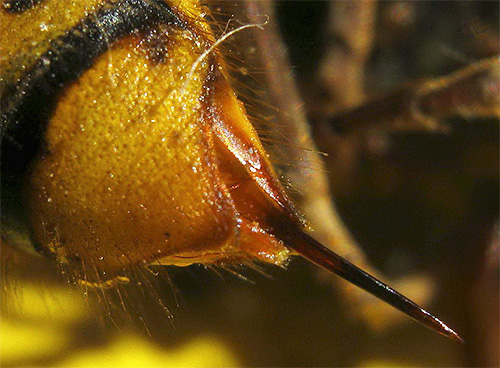
To get rid of wasps in the ground and not cause harm to your health, all procedures for the destruction of insects should be carried out:
- at nightfall, when the wasps hide in the nest and are less active at all;
- in thick clothes with long sleeves, gloves and a beekeeper's mask;
- without sudden movements and screams.
If suddenly something went wrong, the wasps began to fly out of the hole and try to attack, you should quickly but smoothly walk away from their nest and hide in a closed room. Only a few hours later, the operation to get rid of earth wasps can be repeated again (and it is better to postpone it for a day).
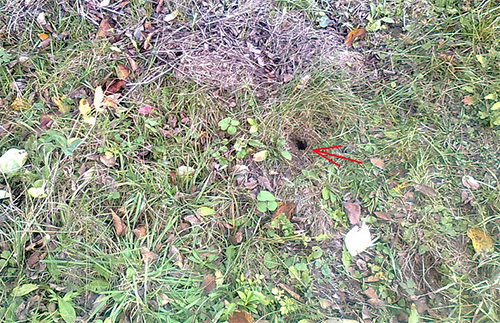


Feedback
“We tried to bring the wasps out of the ground, but everything turned out only from the third time. Once the nest was poured with boiling water, and the whole bucket was boiled and poured, but the wasps were only slightly smaller. Then they simply closed their hole with a stone. It did not help, they dug a new course near him. In the end, her husband could not stand it, he spread several liters of Karbofos and filled them with the whole nest.It worked immediately. I poured it in the evening so that no one would bite him, and in the morning we did not see even a single wasp. ”
Olga, Raisin
Well, if you are still seriously going to get rid of the earth wasps on your plot - it remains only to choose the method you like and, observing safety precautions, act!
And this is how the “earthen” wasp digs a hole ...
Earthen Wasp and Spider Battle


